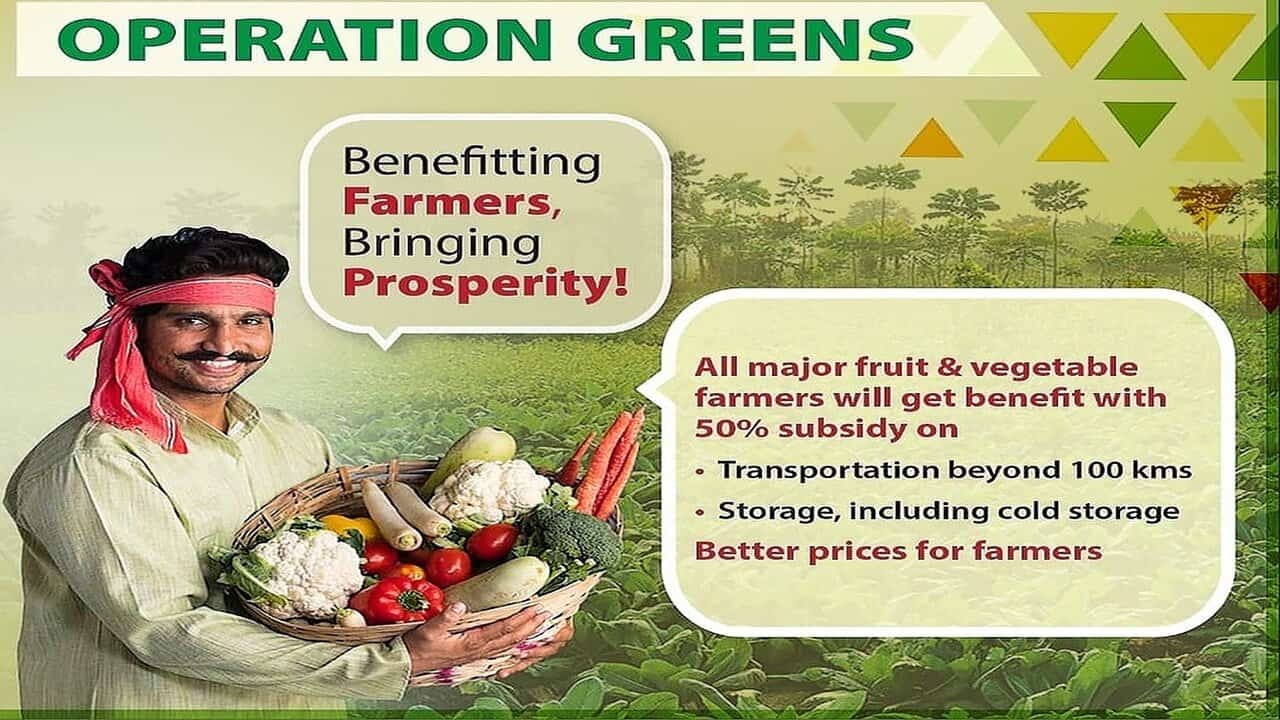The Operation Greens scheme was announced by the Finance Minister in the Union Budget 2018-2019 with an outlay of 500 crores. It aims to promote farmer-producer organizations (FPOs), processing facilities, agri-logistics, and professional management of TOP (tomatoes, onions, and potatoes) crops to ensure fair prices for farmers and availability of crops throughout the year without price volatility.
Objectives of Operation Greens
The key objectives of the Operation Greens scheme are:
Stabilize Prices for Consumers and Producers
- Proper planning in the production of TOP clusters
- Introduction of dual-use crop varieties that can provide multiple harvests in a year
- Help fix remunerative and stable prices for farmers’ produce through demand-supply management
Improve Farmer Income
- Targeted interventions to strengthen FPOs and TOP crop production clusters
- Facilitate access to credit, quality inputs, and extension services
- Connect farmers with high value markets to improve price realization
Reduce Post-Harvest Losses
- Create modern farm-gate primary processing infrastructure
- Develop decentralized pack houses, sorting, grading units
- Build appropriate climate-controlled storage capacity
- Develop seamless agri-logistics linking farms to markets
Increase Food Processing Capacities
- Promote mega food parks focused on TOP crop value addition
- Facilitate private investments into TOP crop processing capacities
- Enable firm linkages between production clusters and food processors through contract farming
Market Intelligence and Data Collection
- Set up an online real-time market intelligence network
- Collect granular data on prices, demand, supply, production of TOP crops
- Use technology and data analytics for production planning
Strategies of Operation Greens
The scheme has two key strategies – short-term price stabilization measures and long-term integrated value chain development projects.
Short-Term Price Stabilization Measures
- NAFED Interventions: NAFED appointed as the nodal agency to undertake direct market interventions like procurement and calibrated release for price stabilization
- Transportation subsidy: 50% subsidy on transportation, storage of TOP crops from production to consumption centers
- Zonal planning: Divide country into zones of surplus and deficit for TOP crops based on seasonal production; arrange smooth inter-zonal movement
Long-Term Integrated Value Chain Development
- Production clusters: Identify TOP crop production clusters with concentration of small farmers
- Common infrastructure: Promote common pack houses, sorting-grading infrastructure in production clusters through FPOs
- Agri-logistics: Facilitate seamless agri-logistics connecting farms to processors and markets
- FPO promotion: Enable FPOs to collectively leverage economies of scale in production and marketing
- Farmer outreach: Extend technology, best practices to small farmers for yield improvement and quality enhancement
- Processing facilities: Create modern processing and packaging infrastructure through private investments
- Market linkages: Develop organized linkages between FPOs, farmers, processors and organized retailers; promote contract farming
- E-platform: Build online platform to track TOP crop demand-supply; help farmers with price discovery
Key Components and Progress
Some major components and progress under the scheme are:
NAFED as Central Nodal Agency
- To undertake pan-India market intervention for price stabilization
Hub and Spoke Model
- NAFED to integrate TOP crop value chain stakeholders onto a common platform
Federated FPO Model Promotion
- Cluster-based FPO Federations to aggregate supplies from member FPOs
NAFED Bazar Mobile App
- Connecting farmers and FPOs directly with retail and bulk buyers
Around 100 FPOs Supported
- For projects related to processing, branding, marketing etc
30% of Budget Allocated to NE States
- For air transportation subsidy of fruits and vegetables
Impact Assessment Study
- Being done by IIM Lucknow to formulate future strategy
Key Impact Areas
The scheme aims to positively impact several areas in the TOP crop value chain:
Boost in Farmer Incomes
- Higher price realization compared to intermediaries
- Lower post-harvest losses driving higher marketable surplus
- Access to direct retail markets through e-platforms
Consumer Price Stability
- Adequate availability of TOP crops across seasons
- Enhanced supply chain efficiency
- Smooth demand-supply balancing
Food Processing Industry Growth
- Assured supply of good quality TOP crop raw materials
- Growth inProcessing and packaging infrastructure
- Improved capacity utilization and exports
Rural Economy Multiplier Effect
- Promotion of farmer collectives like FPOs and Cooperatives
- Agri MSME development across logistics and warehousing
- Ancillary services growth around crop aggregation hubs
Challenges and Mitigation Plans
Some key challenges anticipated in scheme implementation include:
Infrastructure Constraints
- Inadequate cold chain, storage and transport infrastructure
- Mitigation: Support creation of pack houses, pre-cooling units, reefer vehicles, cold storages, ripening chambers
Under-developed Market Linkages
- Weak linkages between production clusters, processors and organized retail
- Mitigation: Promote contract farming models through FPOs; connectivity via e-platforms
Low Level of Farmer Collectives
- Uneven spread in FPO promotion activities required for project viability
- Mitigation: Focus on capacity building, mentoring support to FPOs in project areas
Logistics and Distribution Issues
- Gaps in first mile connectivity and distribution hubs
- Mitigation: Develop transport subsidy schemes; promote rural logistics startups
Way Forward
The way forward to ensure effective scheme implementation and expand its impact is to focus holistically on:
Production Efficiency
- Access to quality inputs, credit and extension services
- Promotion of cluster-based FPO procurement and services
Post-harvest Management
- Expanding pack houses, pre-cooling, storage infrastructure
- Deploying precision technology for sorting, grading quality
Value Addition
- Building robust market linkages via FPOs and contract farming
- Expanding food processing infrastructure in TOP clusters
Marketing Channels
- Developing multi-modal agri-logistics connectivity
- Leveraging e-platforms for farmer price discovery
Through the Operation Greens scheme, the government aims to replicate the success story of the Operation Flood in milk for TOP crops. The scheme has immense potential to transform the TOP crop value chain by raising farmer incomes, reducing losses and benefiting producers, processors and consumers. Its effective on-ground implementation will be the key to unlocking this potential in a sustainable manner.
The expanded agenda focusing holistically across the value chain – from production to consumption – can truly realize the objectives of price stability, doubled farmer incomes and food processing industry growth over the next decade.


